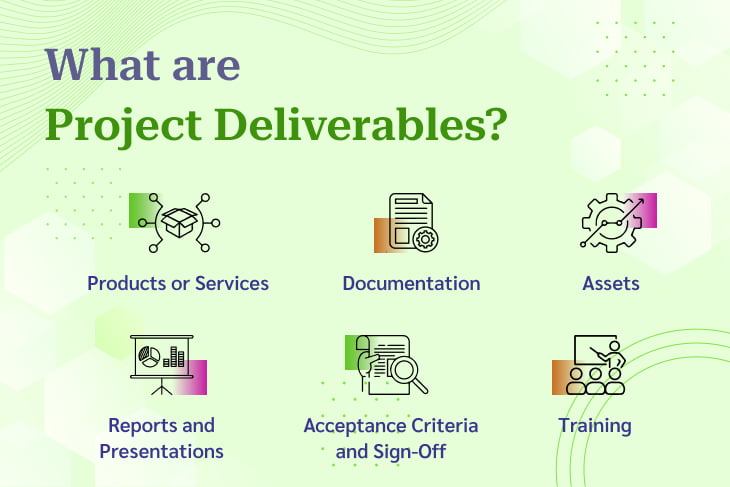Deliverables are essential to the success of a project. They show that your team is meeting project goals or milestones. In this post, we will understand about project deliverables in detail.
What are Project Deliverables?

The observable results or outcomes that are generated once a project is finished are known as project deliverables. These deliverables, which serve as the project’s capstone, are usually specified and approved at the planning stage of the project. They provide the foundation for evaluating the project’s completion and success.
Project deliverables can take various forms depending on the nature of the project but generally include:
- Products or Services: These are the main results of the project and might be real objects like reports, software programs, drawings, prototypes, or actual goods. Deliverables for projects that focus on services might include finished tasks, documentation, or service implementations.
- Documentation: This refers to any written materials or records created throughout the course of the project, including training materials, project plans, requirements papers, technical specifications, user manuals, and process documentation.
- Reports and Presentations: These are formal documents or presentations that summarize the project’s progress, findings, or outcomes. They may include project status reports, milestone presentations, final project reports, or presentations to stakeholders.
- Training: For projects involving the implementation of new systems or processes, deliverables may include training sessions, workshops, or knowledge transfer sessions to ensure that stakeholders understand how to use or maintain the deliverables.
- Assets: These are any additional materials or assets produced as part of the project, such as design files, code repositories, test scripts, or data sets.
- Acceptance Criteria and Sign-Off: Deliverables also include meeting predefined acceptance criteria and obtaining sign-off from stakeholders to confirm that the deliverables meet the agreed-upon requirements and expectations.
What are the categories of project deliverables?
There are 4 types of project deliverables. Internal process, External process, External product, and Internal product. Let’s know each of them:
- Internal process deliverables: Deliverables from an internal process are those that a company sends to a different department within the company. An illustration of an internal process deliverable would be the text or the artwork for that next social media advertisement.
- External process deliverables: It is exactly the same as the prior one, but they are created and sent to outside parties. One example might be a proposal or marketing strategy for a client or prospect. Although it’s not the product you’re selling, it is an important deliverable that fits into or leads to it.
- Internal product deliverables: These things (digital or physical) are supplied to internal teams instead of customers in order to directly fulfill a project need. One example might be a sales report that is internal to the company. It is what you create, not just a portion of it. It is supplied to your teams and workers, and it fulfills a project need.
- External product deliverables: This particular version is meant for your customer; it is the final output that meets a project objective directly.
Conclusion
To sum up, project deliverables are the products that a project produces and gives to its stakeholders once it is finished. The four primary sorts of them are as follows: internal product, external process, internal process, and external product.
It is vital to comprehend the attributes of every kind of deliverable in order to plan, carry out, and oversee projects efficiently. Teams may improve project success rates, guarantee alignment with stakeholder expectations, and eventually support corporate goals by precisely defining and communicating deliverables.
Frequently asked questions
What is the significance of project deliverables?
Project deliverables serve as tangible evidence of project completion and success. They provide stakeholders with concrete results that meet their expectations and requirements, ultimately contributing to the achievement of project goals.
How do you determine deliverables?
Deliverables are typically identified and defined during the project initiation phase. This involves engaging stakeholders to understand their needs and expectations, conducting thorough project planning, and clearly documenting deliverables in the project scope statement.
What are some common challenges in managing deliverables?
Common challenges in managing deliverables include scope creep, changes in stakeholder requirements, resource constraints, and unclear project objectives. Effective communication, stakeholder engagement, and robust change management processes can help address these challenges.
How do you ensure the quality of deliverables?
Ensuring the quality of deliverables involves establishing clear quality standards and criteria, conducting regular reviews and inspections, implementing quality assurance processes, and seeking feedback from stakeholders throughout the project lifecycle.
What role do project managers play in managing deliverables?
Project managers are responsible for defining, planning, executing, and controlling project activities, including managing project deliverables. They play a critical role in ensuring that deliverables are completed on time, within budget, and according to quality standards, while also addressing any issues or risks that may arise.

